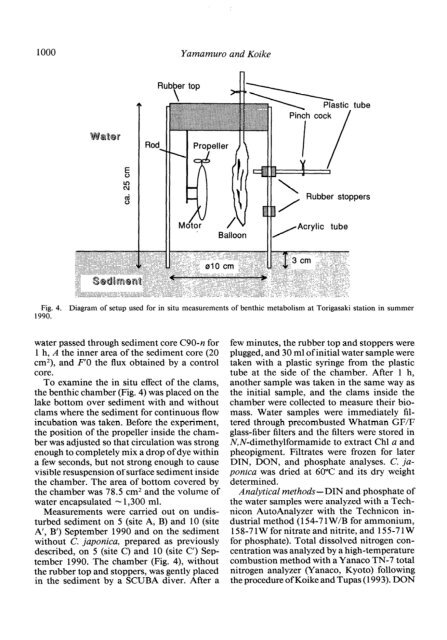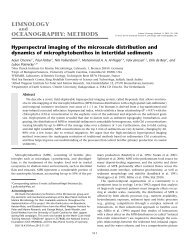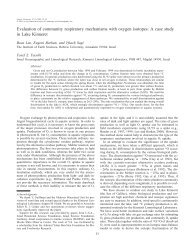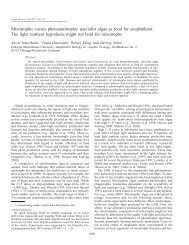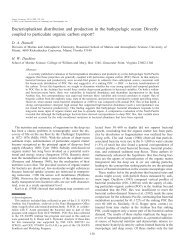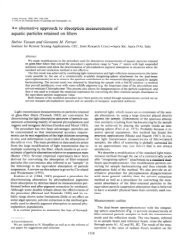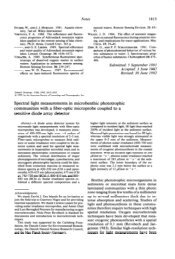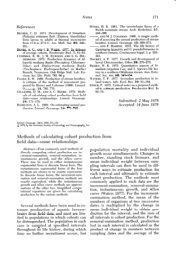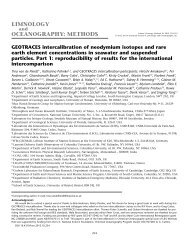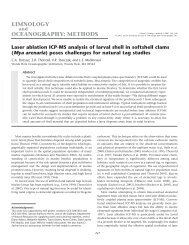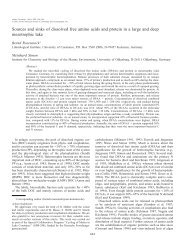Download - ASLO
Download - ASLO
Download - ASLO
You also want an ePaper? Increase the reach of your titles
YUMPU automatically turns print PDFs into web optimized ePapers that Google loves.
1000 Yamamuro and Koike<br />
Rubber stoppers<br />
Fig. 4. Diagram of setup used for in situ measurements of benthic metabolism at Torigasaki station in summer<br />
1996.<br />
water passed through sediment core C90-n for<br />
1 h, A the inner area of the sediment core (20<br />
cm2), and F’O the flux obtained by a control<br />
core.<br />
To examine the in situ effect of the clams,<br />
the benthic chamber (Fig. 4) was placed on the<br />
lake bottom over sediment with and without<br />
clams where the sediment for continuous flow<br />
incubation was taken. Before the experiment,<br />
the position of the propeller inside the chamber<br />
was adjusted so that circulation was strong<br />
enough to completely mix a drop of dye within<br />
a few seconds, but not strong enough to cause<br />
visible resuspension of surface sediment inside<br />
the chamber. The area of bottom covered by<br />
the chamber was 78.5 cm2 and the volume of<br />
water encapsulated - 1,300 ml.<br />
Measurements were carried out on undisturbed<br />
sediment on 5 (site A, B) and 10 (site<br />
A’, B’) September 1990 and on the sediment<br />
without C. japonica, prepared as previously<br />
described, on 5 (site C) and 10 (site C’) September<br />
1990. The chamber (Fig. 4), without<br />
the rubber top and stoppers, was gently placed<br />
in the sediment by a SCUBA diver. After a<br />
few minutes, the rubber top and stoppers were<br />
plugged, and 30 ml of initial water sample were<br />
taken with a plastic syringe from the plastic<br />
tube at the side of the chamber. After 1 h,<br />
another sample was taken in the same way as<br />
the initial sample, and the clams inside the<br />
chamber were collected to measure their biomass.<br />
Water samples were immediately filtered<br />
through precombusted Whatman GF/F<br />
glass-fiber filters and the filters were stored in<br />
N,N-dimethylformamide to extract Chl a and<br />
pheopigment. Filtrates were frozen for later<br />
DIN, DON, and phosphate analyses. C. japonica<br />
was dried at 60°C and its dry weight<br />
determined.<br />
Analytical methods-DIN and phosphate of<br />
the water samples were analyzed with a Technicon<br />
AutoAnalyzer with the Technicon industrial<br />
method (154-7 1 W/B for ammonium,<br />
158-71Wfornitrateandnitrite,and 155-71W<br />
for phosphate). Total dissolved nitrogen concentration<br />
was analyzed by a high-temperature<br />
combustion method with a Yanaco TN-7 total<br />
nitrogen analyzer (Yanaco, Kyoto) following<br />
the procedure of Koike and Tupas (1993). DON


